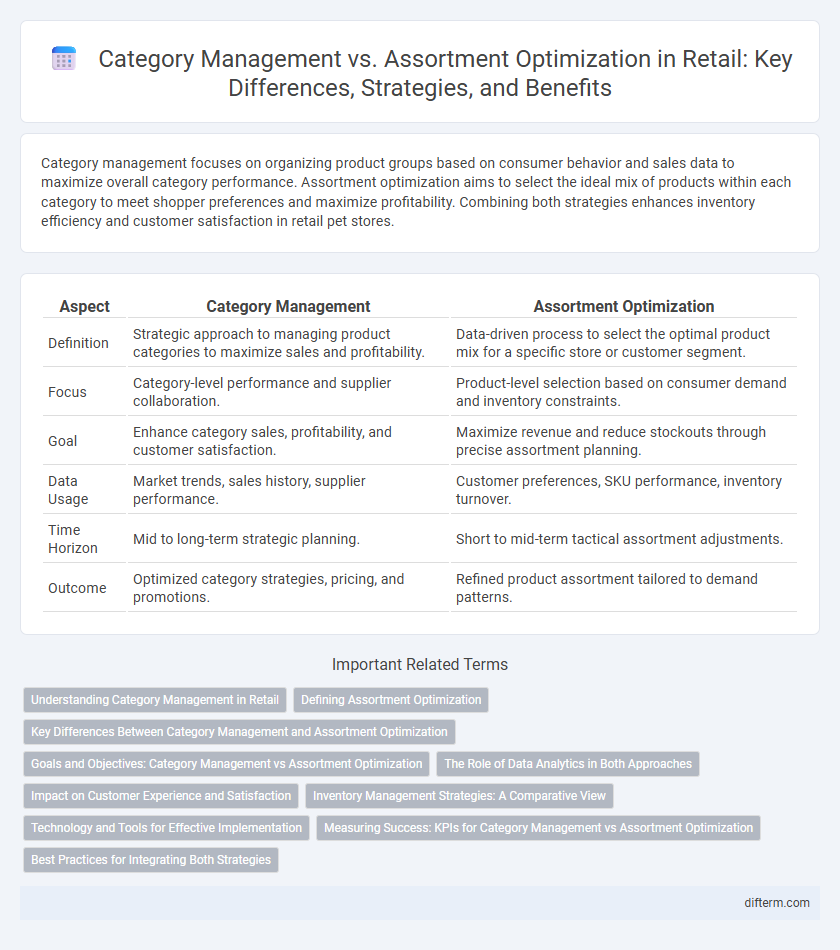Category management focuses on organizing product groups based on consumer behavior and sales data to maximize overall category performance. Assortment optimization aims to select the ideal mix of products within each category to meet shopper preferences and maximize profitability. Combining both strategies enhances inventory efficiency and customer satisfaction in retail pet stores.
Table of Comparison
| Aspect | Category Management | Assortment Optimization |
|---|---|---|
| Definition | Strategic approach to managing product categories to maximize sales and profitability. | Data-driven process to select the optimal product mix for a specific store or customer segment. |
| Focus | Category-level performance and supplier collaboration. | Product-level selection based on consumer demand and inventory constraints. |
| Goal | Enhance category sales, profitability, and customer satisfaction. | Maximize revenue and reduce stockouts through precise assortment planning. |
| Data Usage | Market trends, sales history, supplier performance. | Customer preferences, SKU performance, inventory turnover. |
| Time Horizon | Mid to long-term strategic planning. | Short to mid-term tactical assortment adjustments. |
| Outcome | Optimized category strategies, pricing, and promotions. | Refined product assortment tailored to demand patterns. |
Understanding Category Management in Retail
Category Management in retail involves organizing products into distinct groups to improve sales and customer satisfaction by targeting specific consumer needs and behaviors. It leverages data analysis, supplier collaboration, and market trends to strategically plan product assortments, pricing, and promotions within each category. This approach enhances inventory management, maximizes shelf space efficiency, and drives profitable growth by aligning product offerings with shopper preferences.
Defining Assortment Optimization
Assortment optimization in retail involves analyzing customer preferences, sales data, and market trends to select the ideal mix of products that maximizes profitability and meets consumer demand. It uses data-driven insights and algorithms to refine product selection, reduce inventory costs, and improve shelf space efficiency. Unlike category management, which focuses on managing product categories strategically, assortment optimization zeroes in on pinpointing the best combination of SKUs within those categories.
Key Differences Between Category Management and Assortment Optimization
Category management focuses on organizing product groups based on consumer behavior and strategic business goals to maximize overall category profitability. Assortment optimization utilizes data-driven techniques to select the ideal mix of products within a category that meets local demand and inventory constraints. Key differences include category management's broader scope covering vendor relationships and merchandising strategy, while assortment optimization concentrates specifically on product-level selection and inventory allocation.
Goals and Objectives: Category Management vs Assortment Optimization
Category management aims to maximize overall category profitability by aligning product mix, pricing, and promotions with consumer demand and supplier capabilities. Assortment optimization focuses on selecting the ideal product variety within a category to boost sales, reduce inventory costs, and enhance customer satisfaction. Both strategies drive revenue growth but differ in scope; category management takes a holistic approach to category performance, while assortment optimization hones in on product-level decisions to meet specific market needs.
The Role of Data Analytics in Both Approaches
Data analytics drives Category Management by enabling retailers to analyze sales trends, customer preferences, and market dynamics, facilitating strategic decisions on product placement and pricing. In Assortment Optimization, data analytics refines inventory selection by identifying high-performing SKUs and eliminating underperformers, improving shelf efficiency and sales margins. Leveraging predictive analytics and machine learning enhances both approaches by providing real-time insights for dynamic assortment adjustments and category performance improvements.
Impact on Customer Experience and Satisfaction
Category Management improves customer experience by aligning product categories with shopper needs, making it easier for customers to navigate and find relevant products. Assortment Optimization enhances satisfaction through data-driven selection of products that meet local demand and preferences, reducing out-of-stock situations and increasing product relevance. Together, these strategies boost customer loyalty by delivering tailored shopping experiences and ensuring the availability of the right products at the right time.
Inventory Management Strategies: A Comparative View
Category Management focuses on grouping products into strategic categories to maximize shelf efficiency and enhance customer experience, while Assortment Optimization uses data analytics to tailor product mixes that match consumer demand and store-specific sales patterns. Inventory management in Category Management emphasizes balancing stock levels across categories to prevent overstock or stockouts, whereas Assortment Optimization prioritizes dynamic inventory adjustments based on real-time sales and predictive analytics to optimize turnover and reduce carrying costs. Both strategies require integrated supply chain coordination but differ in approach--Category Management targets broad category goals, and Assortment Optimization hones in on fine-tuned SKU-level inventory precision.
Technology and Tools for Effective Implementation
Category management and assortment optimization rely heavily on advanced technology tools such as AI-powered analytics, machine learning algorithms, and real-time data integration platforms to drive effective decision-making. Retailers utilize predictive modeling software and demand forecasting systems to tailor product categories according to consumer behavior and market trends, enhancing overall inventory efficiency. Integration of these technologies ensures dynamic assortment adjustments, improved supplier collaboration, and maximized sales performance through data-driven insights.
Measuring Success: KPIs for Category Management vs Assortment Optimization
Category management success is typically measured by KPIs such as category sales growth, market share, and gross margin return on investment (GMROI), which reflect overall category profitability and customer satisfaction. Assortment optimization KPIs focus on product-level metrics like SKU productivity, stock turnover rate, and sell-through percentage to ensure the right mix of products meets consumer demand efficiently. Comparing these KPIs helps retailers balance strategic category profitability with tactical inventory effectiveness for optimal retail performance.
Best Practices for Integrating Both Strategies
Integrating category management and assortment optimization requires leveraging data analytics to align product assortments with consumer demand and category objectives. Employing advanced demand forecasting tools and customer segmentation enhances the precision of assortment decisions while maintaining category profitability. Collaborative cross-functional teams ensure continuous monitoring and adjustment, driving a synchronized strategy that maximizes sales and inventory efficiency.
Category Management vs Assortment Optimization Infographic

 difterm.com
difterm.com